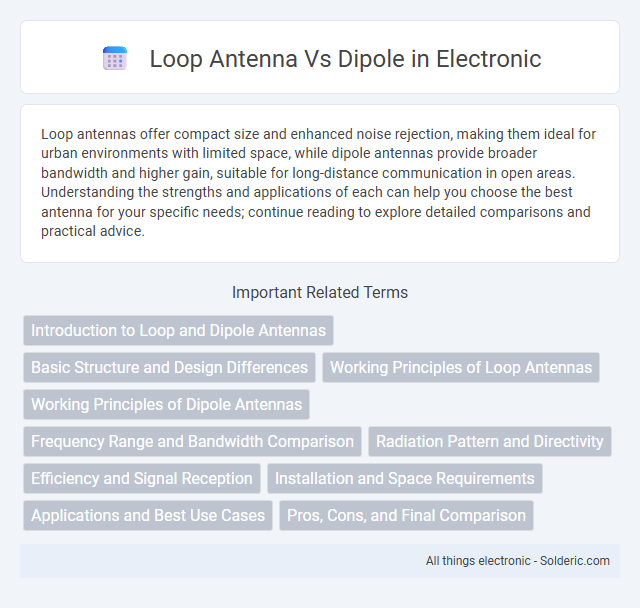Loop antennas offer compact size and enhanced noise rejection, making them ideal for urban environments with limited space, while dipole antennas provide broader bandwidth and higher gain, suitable for long-distance communication in open areas. Understanding the strengths and applications of each can help you choose the best antenna for your specific needs; continue reading to explore detailed comparisons and practical advice.
Comparison Table
| Feature | Loop Antenna | Dipole Antenna |
|---|---|---|
| Basic Structure | Closed loop conductor (usually circular or square) | Two linear conductive elements in a straight line |
| Radiation Pattern | Directional, figure-eight pattern with nulls perpendicular to the loop plane | Bidirectional, figure-eight pattern broadside to the elements |
| Impedance | Low to moderate (varies with size and frequency) | Approximately 73 ohms (resonant dipole) |
| Size | Compact for low frequencies | Half wavelength of operating frequency |
| Bandwidth | Narrow bandwidth | Moderate bandwidth |
| Polarization | Magnetic or electric depending on orientation | Linear, usually horizontal or vertical |
| Application | Direction finding, HF/VLF reception | General-purpose transmission and reception |
| Installation | Requires careful orientation and tuning | Simple installation, easier tuning |
Introduction to Loop and Dipole Antennas
Loop antennas, characterized by their enclosed conductive loops, excel in compact design and magnetic field reception, commonly used in direction finding and low-frequency applications. Dipole antennas consist of two conductive elements aligned end-to-end, offering broad bandwidth, simplicity, and high radiation efficiency, widely deployed in VHF and UHF communication systems. The fundamental difference lies in radiation patterns and polarization, with loops producing primarily magnetic fields and dipoles generating electric dipole radiation.
Basic Structure and Design Differences
A loop antenna consists of a closed conducting loop, often circular or square, designed to detect magnetic fields and is typically smaller in size compared to a dipole. A dipole antenna features two straight, collinear conductive elements aligned end-to-end, optimized for receiving or transmitting electric field components. Your choice depends on the intended frequency range and spatial constraints, as loop antennas are compact with directionality, while dipoles offer broader bandwidth and straightforward design.
Working Principles of Loop Antennas
Loop antennas operate by inducing voltage through magnetic flux changes within the loop conductor, effectively capturing the magnetic component of electromagnetic waves. Their working principle relies on Faraday's law of electromagnetic induction, where the loop area and current direction determine signal reception or transmission strength. Compared to dipole antennas that primarily respond to the electric field component, loop antennas excel in environments with strong magnetic fields and provide directional sensitivity with reduced noise interference.
Working Principles of Dipole Antennas
Dipole antennas operate by creating an oscillating current along two conductive elements, generating electromagnetic waves that radiate efficiently in directions perpendicular to the antenna axis. Their simple structure supports balanced transmission and reception, making them ideal for a wide range of radio frequency applications. Understanding your dipole antenna's resonance and impedance matching ensures optimal signal strength and broadband performance.
Frequency Range and Bandwidth Comparison
Loop antennas typically operate efficiently in a narrower frequency range, often favored for low to medium frequencies with moderate bandwidth, making them suitable for applications like AM radio and direction finding. Dipole antennas provide a wider frequency range and broader bandwidth, enabling better performance across VHF and UHF bands commonly used in FM radio, television, and mobile communications. The bandwidth of a dipole can be enhanced with design variations such as thicker elements or loading coils, while loop antennas generally maintain a more limited bandwidth due to their compact size and resonant properties.
Radiation Pattern and Directivity
Loop antennas typically exhibit a figure-eight radiation pattern with nulls perpendicular to the plane of the loop, offering higher directivity in those directions. Dipole antennas have a broadside radiation pattern with maximum radiation perpendicular to the antenna axis, providing more uniform coverage but lower directivity compared to loops. Understanding these patterns helps you choose the right antenna based on your need for focused signal transmission or wider area coverage.
Efficiency and Signal Reception
Loop antennas generally offer higher efficiency in receiving weak signals due to their reduced noise pickup and ability to reject electromagnetic interference compared to dipole antennas. Dipole antennas, while easier to construct and tune, tend to have broader reception patterns but lower sensitivity in noisy environments, impacting overall signal clarity. The choice between loop and dipole antennas depends on the specific application, with loops excelling in environments with significant electromagnetic noise and dipoles performing well in open, less noisy settings.
Installation and Space Requirements
Loop antennas require less installation space compared to dipole antennas, making them ideal for limited areas or urban environments. Dipole antennas need a longer horizontal span, often requiring support structures like trees or poles, which can complicate installation in tight spaces. Your choice depends on available space and ease of mounting, with loop antennas offering more compact and versatile installation options.
Applications and Best Use Cases
Loop antennas are ideal for direction-finding applications and low-frequency reception due to their compact size and ability to pick up magnetic fields with reduced noise. Dipole antennas excel in general-purpose transmission and reception, particularly for HF and VHF frequencies, offering a simple design with balanced radiation patterns. Your choice depends on whether you prioritize compact directional sensitivity (loop) or wideband, efficient omnidirectional communication (dipole).
Pros, Cons, and Final Comparison
Loop antennas offer compact size and better noise immunity, making them ideal for urban or limited-space environments, but their lower bandwidth and sensitivity may limit performance for some applications. Dipole antennas provide broader frequency coverage and higher gain, enhancing signal strength and range, yet they require more space and are more susceptible to noise interference. Your choice depends on whether physical space or signal quality is a higher priority, with dipoles preferred for maximum reception and loops favored for portability and noise reduction.
loop antenna vs dipole Infographic

 solderic.com
solderic.com